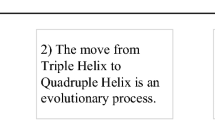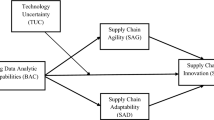Abstract
This paper examines the contextual factors that influenced an open innovation project failure. To this end the paper adds to the discussion on open innovation in non high-tech settings and highlights the importance of contextual factors as determinants of success or failure within the open innovation paradigm. It is based on a case study performed at PowerDrive, a manufacturer of hydraulic drive systems, and three of its customers, and follows their attempt to co-create new value-adding services through the innovative use of information technology in the form of a remote monitoring system. The study shows that open innovation project success cannot be measured only in terms of coherence with set targets of quality, time, and costs, but also has to include the creation of mutual value and the development of trust and strong inter-organizational relationships. Furthermore, the role and character of information technology has to be considered and accounted for and the social context made explicit. By managing the value creation process, the value proposal stands a better chance of indeed providing value.
Similar content being viewed by others
References
Arora A, Fosfuri A, Gambardella A (2001a) Markets for technology: the economics of innovation and corporate strategy. MIT Press, Cambridge, MA
Arora A, Fosfuri A, Gambardella A (2001b) Markets for technology and their implications for corporate strategy. Ind Corp Change 10(2):419–451
Barrett M, Walsham G (1995) Using IT to support business innovation: a case study of the London insurance market. Scand J Inform Syst 7(2):3–22
Berggren U, and Bergkvist T (2006) Industrial service innovations—a disregarded growth engine (Industriföretagens servicecinnovationer –en outnyttjad tillväxtfaktor), NUTEK, Report B2006:6, Available at: http://publikationer.tillvaxtverket.se. Accessed 6 May 2009
Bjorvatn K, Norman V, Orvedal L (2008) On the road to samarkand: globalisation and the Swedish economy, Expert report no. 21 to Sweden’s globalisation council, The globalisation council 2008, available at: http://www.regeringen.se/content/1/c6/11/32/24/f4d9dafc.pdf. Accessed 6 May 2009
Chesbrough H (2003) The era of open innovation. MIT Sloan Manage Rev 44(3):35–41
Chesbrough H (2006a) Open innovation: a new paradigm for understanding industrial innovation. In: Chesbrough H, Vanhaverbeke W, West J (eds) Open innovation. Researching a new paradigm. Oxford University Press Inc., New York, pp 1–12
Chesbrough H (2006b) Open innovation. The new imperative for creating and profiting from technology. Harvard Business School Press, Boston, MA
Chesbrough H, Kardon Crowther A (2006) Beyond high tech: early adopters of open innovation in other industries. R&D Manage 36(3):229–236
Chesbrough H, Rosenbloom RS (2002) The role of the business model in capturing value from innovation: evidence from xerox corporation’s technology spin-off companies. Ind Corp Change 11(3):529–555
Chesbrough H, Schwartz K (2007) Innovating business models with co-development partnerships. Res Technol Manage 50(1):55–59
Chesbrough H, Spohrer J (2006) A research manifesto for service sciences. Commun ACM 49(7):35–40
Cohen WM, Levinthal DA (1990) Absorptive capacity: a new perspective on learning and innovation. Adm Sci Q 35:128–135
Dahlander L, Gann D (2007) How open is innovation? Presented at the DRUID Summer Conference 2007 on Appropriability, proximity, routines and innovation, Copenhagen, CBS, Denmark, June 18–20, 2007
Dodgson M, Gann D, Salter A (2006) The role of technology in the shift towards open innovation: the case of procter and gamble. R&D Manage 36(3):333–346
Elmquist M, Le Masson P (2009) The value of a ‘failed’ R&D project: an emerging evaluation framework for building innovative capabilities. R&D Manage 39(2):136–152
Fleming L, Waguespack DM (2007) Brokerage, boundary spanning, and leadership in open innovation communities. Organ Sci 18(2):165–180
Gallivan MJ (2001) Striking a balance between trust and control in a virtual organization: a content analysis of open source software case studies. Inform Syst J 11:277–304
Gulati R (2006) Alliances and networks. Strateg Manage J 19(4):293–317
Han T, Yang B-S (2006) Development of an e-maintenance system integrating advanced techniques. Comput Ind 57(6):569–580
Jaffe A, Trajtenberg M, Henderson R (1993) Geographic localization of knowledge spillovers as evidenced by patent citations. Q J Econ 108(3):557–598
Jones MR, Karsten H (2009) Divided by a common language? A response to Marshall Scott Poole. MIS Q 33(3):589–595
Jonsson K (2006) The embedded panopticon: visibility issues of remote diagnostics surveillance. Scand J Inform Syst 18(2):7–28
Jonsson K, Westergren UH, Holmstrom J (2008) Technologies for value creation: an exploration of remote monitoring systems in the manufacturing industry. Inform Syst J 18(3):227–245
Klein HK, Myers MD (1999) A set of principles for conducting and evaluating interpretive field studies in information systems. MIS Q 23(1):67–93
Kothandaraman P, Wilson DT (2001) The future of competition: value-creating networks. Ind Mark Manage 30:379–389
Lee J, Ni J, Djurdjanovic D, Qiu H, Liao H (2006) Intelligent prognostics tools and maintenance. Comput Ind 57(6):476–489
Maglio, Spohrer (2008) Fundamentals of service science. J Acad Mark Sci 36:18–20
Markus L, Robey D (1998) Information technology and organizational change: causal structure in theory and research. Manage Sci 34(5):583–598
Mason J (2002) Qualitative researching, 2nd edn. Sage Publications, London
Miles MB, Huberman AM (1994) Qualitative data analysis: an expanded sourcebook. Sage Publications, London
Monteiro E, Hanseth O (1996) Social shaping of information infrastructure: on being specific about the technology. In: Orlikowski W, Walsham G, Jones MR, DeGross JI (eds) Information technology and changes in organisational work. Chapman & Hall, London, pp 325–343
Normann R, Ramirez R (1993) From value chain to value constellation: designing interactive strategy. Harv Bus Rev 71:65–77
Orlikowski WJ, Iacono S (2001) Research commentary: desperately seeking the “IT” in IT research–a call to theorizing the IT artifact. Inform Syst Res 12(2):121–134
Pisano GP (1990) The R&D boundaries of the firm: an empirical analysis. Adm Sci Q 35:153–156
Poole MS (2009) Response to Jones and Karsten, “Gidden’s structuration theory and information systems research”. MIS Q 33(3):583–587
Porter M (1985) Competitive advantage: creating and sustaining superior performance. Free Press, NY, USA
Rogers EM (1995) Diffusion of innovations, 4th edn. The Free Press, New York
Rouse WB, Baba ML (2006) Enterprise transformation. Commun ACM 49(7):67–72
Stanoevska-Slabeva K, Heitmann M (2003) Impact of mobile ad hoc networks on the mobile value system. Paper presented at the 2nd international conference on mobile business (ICMB), Vienna, Austria, 23 June 2003
Tallman S, Phene A (2007) Leveraging knowledge across geographic boundaries. Organ Sci 18(2):252–260
Van de Ven AH (2005) Running in pack to develop knowledge-intensive technologies. MIS Q 29(2):365–378
Van de Ven AH, Polley DE, Garud R, Venkataraman S (1999) The innovation journey. Oxford University Press, New York
Vanhaverbeke W (2006) The inter-organizational context of open innovation. In: Chesbrough H, Vanhaverbeke W, West J (eds) Open innovation. Researching a new paradigm. Oxford University Press Inc, New York, pp 205–219
Vanhaverbeke W, Van de Vrande V, Cloodt M (2008) Connecting absorptive capacity and open innovation (February 7, 2008). Available at SSRN: http://ssrn.com/abstract=1091265
Vargo SL, Lusch RF (2004) Evolving to a new dominant logic for marketing. J Mark 68:1–17
Vargo SL, Lusch RF (2008) Service-dominant logic: continuing the evolution. J Acad Mark Sci 36(1):1–10
Vargo SL, Maglio PP, Akaka MA (2008) On value and value co-creation: a service systems and service logic perspective. Eur Manage J 26:145–152
Von Hippel E, Von Krogh G (2003) Open source software and the “private-collective” innovation model: issues for organization science. Organ Sci 14(2):209–223
Walsham G (1993) Interpreting information systems in organizations. Wiley, Chichester
Westergren UH (2007) Partnership outsourcing evolution—the process of creating and maintaining a network of actors. In: Österle H, Schelp J, Winter R (eds) Proceedings of the fifteenth European conference on information systems, University of St. Gallen, St. Gallen, Switzerland, pp 1179–1189
Westergren UH (2007) From senses to sensors -strategies for maintaining and enhancing competence in a virtual organization. In: Crowston K, Sieber S, Wynn E (eds) Proceedings of IFIP 8.2/9.5 conference on Virtuality and virtualization, Portland, OR, USA, 28–31 July 2007, pp 281–293
Westergren UH, Holmstrom J (2008) Outsourcing as open innovation: exploring preconditions for the open innovation model in the process industry. In: Proceedings of ICIS 2008, Paris, France
Yin RK (2003) Case study research: design and methods, 3rd edn. Sage Publications, Thousand Oaks
Author information
Authors and Affiliations
Corresponding author
Rights and permissions
About this article
Cite this article
Westergren, U.H. Opening up innovation: the impact of contextual factors on the co-creation of IT-enabled value adding services within the manufacturing industry. Inf Syst E-Bus Manage 9, 223–245 (2011). https://doi.org/10.1007/s10257-010-0144-2
Received:
Revised:
Accepted:
Published:
Issue Date:
DOI: https://doi.org/10.1007/s10257-010-0144-2




